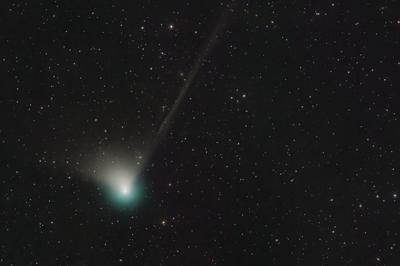A local professor says a green comet will be visible in the night sky for the next few weeks.
Valerie Rapson, physics and astronomy professor at SUNY Oneonta, said the comet is already visible using high-powered binoculars or a 4-inch telescope, but “might be visible to the naked eye” on Feb. 1, when it is closest to Earth.
“The best time to look is between 10 p.m. and midnight,” she said. The comet will be in the northeast sky, just to the right of the north star, she said. “It’s going to be higher in the sky as the days go by,” she said.
She said people can try to view it with the naked eye for a few days after Feb. 1, but then binoculars and telescopes will be needed to view it for a few more weeks.
According to an Associated Press article, the comet will be near Mars by Feb. 10.
It has been about 50,000 years since the comet last made its appearance in the night sky over Earth, she said. The last time it made its appearance, Neanderthals walked the planet, the AP article said.
“We don’t know if it will return in tens of thousands of years,” Rapson said. “There is also a possibility we will never see it again in this solar system.”
Every time the comet skirts the sun and planets, their gravitational tugs alter the iceball’s path ever so slightly, leading to major course changes over time, the AP article said. Another wild card: jets of dust and gas streaming off the comet as it heats up near the sun.
The comet — a time capsule from the emerging solar system of 4.5 billion years ago — came from what’s known as the Oort Cloud, well beyond Pluto, the AP article said. This deep-freeze haven for comets is believed to stretch more than one-quarter of the way to the next star.
According to the AP article, the comet was discovered last March by astronomers using the Zwicky Transient Facility, a wide field camera at Caltech’s Palomar Observatory. That explains its official, cumbersome name: comet C/2022 E3 (ZTF). It gets its green color from all the carbon in the gas cloud, or coma, surrounding the nucleus, the article said.
“Unfortunately I haven’t seen it yet and the weather forecast next week doesn’t look promising,” Rapson said. “We were hoping to have an event at the college.”
She said if the weather does clear, people can look at the college’s social media pages to see if an observation night has been scheduled at the observatory.
The SUNY Oneonta Observatory, which houses the largest telescope in the state, is at the College Camp at 119 Hoffman Road.








Commented
Sorry, there are no recent results for popular commented articles.